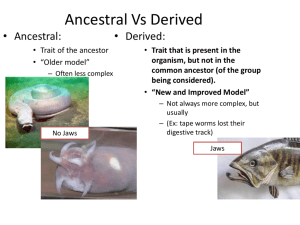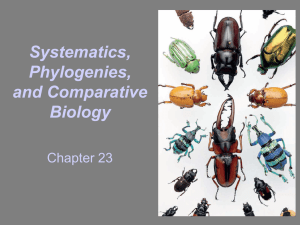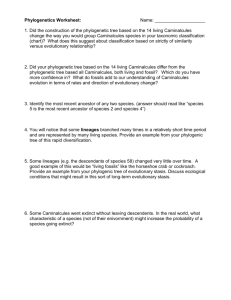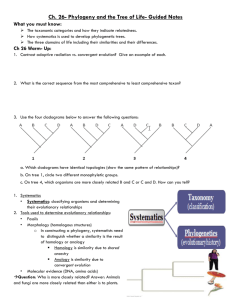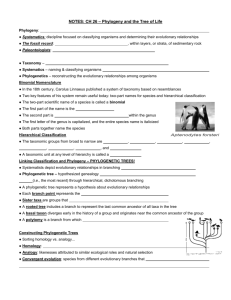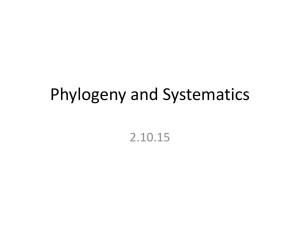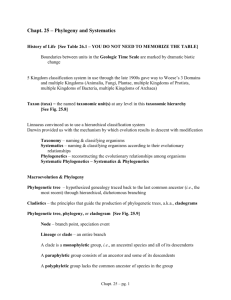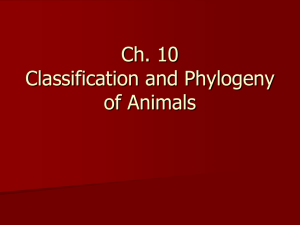Chapter 23
advertisement
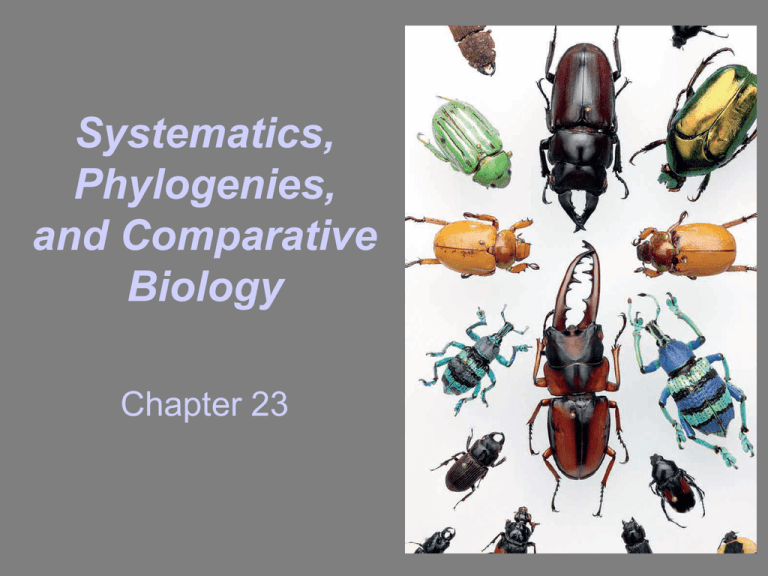
Systematics, Phylogenies, and Comparative Biology Chapter 23 1 Systematics • All organisms share many characteristics: – – – – Composed of one or more cells Carry out metabolism Transfer energy with ATP Encode hereditary information in DNA • Tremendous diversity of life – From bacteria to whales to trees 2 http://www.pbs.org/wgbh/nova/evolution/ten-great-advances-evolution.html http://www.mun.ca/biology/scarr/2900_Incomplete_Fossil_Record.htm • Biologists group organisms based on shared characteristics and newer molecular sequence data – Since fossil records are not complete,… – Scientists rely on other types of evidence to establish the best hypothesis of evolutionary relationships 3 • Systematics – Reconstruction and study of evolutionary relationships • Phylogeny – Hypothesis about patterns of relationship among species – Cladogram or phylogenetic tree 4 http://paleocave.sciencesortof.com/2010/12/diagraming-evolution-or-how-to-read-a-cladogram/ Copyright © The McGraw-Hill Companies, Inc. Permission required for reproduction or display. Darwin envisioned that all species were descended from a single common ancestor • He depicted this history of life as a branching tree • “Descent with modification” a. 5 Reproduced by kind permission of the Syndics of Cambridge University Library, Darwin’s Notebook ‘B’, ‘Tree of Life’ Sketch, p. 36 from DAR.121 D312 • Similarity may not accurately predict evolutionary relationships – Early systematists relied on the expectation that the greater the time since two species diverged from a common ancestor, the more different they would be – Rates of evolution vary • Evolution may not be unidirectional – Evolution is not always divergent • Convergent evolution – similar characters not derived from common ancestery 7 http://matthewbonnan.wordpress.com/2012/06/02/lets-face-it-birds-are-dinosaurs-part-1/ Cladistics • Derived characteristic – Similarity that is inherited from the most recent common ancestor of an entire group • Ancestral characteristic – Similarity that arose prior to the common ancestor of the group • In cladistics, only shared derived characters (synapomorphies) are considered informative about evolutionary relationships 8 • Characters can be any aspect of the phenotype – Morphology – Behavior – Physiology – DNA • Characters should exist in recognizable character states – Presence vs. absence • Example: Character “teeth” in amniote vertebrates has two states: – present in most mammals and reptiles, and – absent in birds and turtles 9 • Examples of ancestral versus derived characters, often dependent on context, depend on what part of cladogram you are looking at – When looking at vertebrates for example: • Presence of hair is a shared derived feature of mammals • Presence of lungs in mammals is an ancestral feature - also present in amphibians and reptiles • Shared, derived feature of hair suggests that all mammal species share a common ancestor that existed more recently than the common ancestor of mammals, amphibians, and reptiles 10 http://sciencenotes.wordpress.com/2008/05/10/ Manual cladistic analysis • First step is to polarize the characters (are they ancestral or derived?) – Example: polarize “jaws” or “tail” or “hair” means to determine presence or absence in the most recent common ancestor – Outgroup comparison used • Species or group of species that is closely related to, but not a member of, the group under study is designated as the outgroup • Outgroup species do not always exhibit the ancestral condition 11 Let’s look at a group of animals that are vertebrates. We can see that Gorillas and humans share the most derived traits http://www.vanderbilt.edu/peabody/novick/evol_diagrams.html • Cladogram – Depicts a hypothesis of evolutionary relationships • Clade – Species that share a common ancestor as indicated by the possession of shared derived characters – Evolutionary units and refer to a common ancestor and all descendants – Synapomorphy – derived character shared by clade members 14 • Systematists rely on the principle of parsimony, which favors the hypothesis that requires the fewest assumptions 17 http://undsci.berkeley.edu/article/howscienceworks_12 Salamander Frog Lizard Tiger Gorilla Human Salamander Lizard Frog Gorilla Hair loss Amniotic membrane loss Tail loss Tail loss Hair Human Tail loss Hair Amniotic membrane a. Tiger Amniotic membrane b. Based on the principle of parsimony, the cladogram that requires the fewest number of evolutionary changes is favored • The cladogram in (a) requires four changes, whereas… • (b) requires five • (a) is the favored scenario 18 Systematists increasingly use DNA sequence data to construct phylogenies • Large number of characters that can be obtained through sequencing – Instead of looking at teeth or tails or hair, we look at genes or amino acid sequence of proteins as characters (how closely sequenced are certain genes) • Character states are polarized by reference to the sequence of an outgroup • Cladogram is constructed that minimizes the amount of character evolution required 19 http://www.biocompare.com/Application-Notes/41940-Mutation-Detection-For-The-K-Rasand-P16-Genes/ Parsimony also attempts to minimize homoplasies – compare this graph with table on previous slide Copyright © The McGraw-Hill Companies, Inc. Permission required for reproduction or display. Outgroup Species B Species D Species A 8:T 4:T G 8:T C 10:T 2:T C G 6:C G 9:A G Species C C 1:A G 5:C A Homoplastic evolutionary changes Homologous evolutionary changes 21 Other Phylogenetic Methods Potential problems with DNA sequences… • Some characters evolve rapidly, so using parsimony principle may be misleading • Stretches of DNA with no function have high rates of evolution of new character states due to genetic drift • Only 4 character states are possible (A, T, G,C) so there is a high probability that two species will independently evolve the same derived character state at any particular base position… appear homologous when they are not 22 Systematics and Classification • Classification – How we place species and higher groups into the taxonomic hierarchy – should follow evolutionary history – Genus, family, order, class, phylum, kingdom, domain • Monophyletic group (the “goal”) – Includes the most recent common ancestor of the group and all of its descendants (clade) 23 Copyright © The McGraw-Hill Companies, Inc. Permission required for reproduction or display. Red Algae Green Algae Chlorophytes Charophytes Bryophytes Liverworts Hornworts Vascular Plants Mosses • The traditional classification of Plants included 3 groups that we now realize are not monophyletic: the green algae and bryophytes and the plants – The mosses that are in the bryophytes are more closely related to vascular plants 26 http://evolution.berkeley.edu/evosite/evo101/VA1BioSpeciesConcept.shtml Species concepts • Biological species concept (BSC) – Defines species as groups of interbreeding populations that are reproductively isolated • Phylogenetic species concept (PSC) – Species is a population or set of populations characterized by one or more shared derived characters 27 http://evolution.berkeley.edu/evosite/evo101/VA1BioSpeciesConcept.shtml • PSC solves 2 BSC problems – BSC cannot be applied to allopatric (separate) populations – would they interbreed? • PSC looks to the past to see if they have been separated long enough to develop their own derived characters – BSC can be applied only to sexual species • PSC can be applied to both sexual and asexual species 28 Phylogenetics • Basis for all comparative biology • Homologous structures – Derived from the same ancestral source – Dolphin flipper and horse leg 29 http://bytesizebio.net/2009/07/15/distant-homology-and-being-a-little-pregnant/ Phylogenetics • Homoplastic structures are not – Analogous – similar function due to similar selection pressures – Wings of birds and dragonflies • Phylogenetic analysis can help determine which structures are homologous vs. analogous 30 http://www.bio.miami.edu/dana/106/106F05_4.html • Parental care in dinosaurs initially treated as unexpected Fossil dinosaur incubating eggs – Examination of phylogenetic comparison of dinosaurs indicates they are most closely related to crocodiles and birds – both show parental care – Parental care in three groups not convergent (or analogous) but homologous behaviors a. a: Image #5789, photo by D. Finnin/American Museum of Natural History b. b: © Roger De La Harpe/Animals Animals 31 Copyright © The McGraw-Hill Companies, Inc. Permission required for reproduction or display. http://www.cartage.org.lb/en/themes/sciences/botanicalsciences/plantsstructure/plantsstructure/plantsstructure.htm Homoplastic convergence – evolving separately due to convergent evolution • Ex: plant conducting tubes – Sieve tubes facilitate long-distance transport of food and other substances in vascular plants • Essential to the survival of tall plants on land – Brown algae also have sieve elements – Closest ancestor of these two taxa is a single-celled organism that could not have had a multicellular transport system… 33 Copyright © The McGraw-Hill Companies, Inc. Permission required for reproduction or display. Comparative Biology Most complex characters do not evolve in one step • Evolve through a sequence of evolutionary changes • Multiple random mutations over time, multiple selection pressures that favor certain mutations • Initial stages of a character evolved as an adaptation to some environmental selective pressure • Modern-day birds exquisite are flying machines – Wings, feathers, light bones, breastbone 34 http://en.wikipedia.org/wiki/White_feather Comparative Biology • Ex: Vertebrate eye vs. cephalopod (octopus) eye – Both “camera” eyes, look similar – Developmental process is very different – Highly complex structures, independently derived (convergence) – Octopus eye is actually better • Evolution doesn’t necessarily lead to perfection, it leads to what works for the environmental pressures that are present 35 http://www.pnas.org/content/94/6/2098/F1.. http://debivort.org/blog/2010/08/01/beetle-box/ Phylogenetic Analysis Phylogenetics helps explain species diversification • Use phylogenetic analysis to suggest and test hypotheses • Insight into beetle diversification – Correspondence between phylogenetic position and timing of plant origins suggests beetles are remarkably conservative in their diet Beetle box: 102 species of beetles from Madagascar, representing ~0.025% of all described beetle species 36 • • • Beetles are the most diverse animals Some are herbivores (feed on plants) Beetle families that specialize on conifers have deepest branches on this cladogram – Makes sense since conifers evolved earlier than angiosperms (flowering plants) 78 25,00 0 3 40 0 8 1 8 33,400 20 750 10 41,602 1500 24 Number of Species 2000 – It is not the evolution of herbivory itself – Specialization on angiosperms was prerequisite for diversification – Specialization has arisen five times independently within herbivorous beetles – Angiosperm specializing clade is more species-rich than the clade most closely related 85 • Phylogenetic explanations for beetle diversification Tertiary Cretaceous Jurassic Triassic Conifer Cycad Angiosperm 38 http://meetthespeciesdotorg.wordpress.com/2012/08/23/sarah-beynon-on-beetles/ Disease Evolution AIDS first recognized in 1980s • Current estimate: > 33 million people infected with human immunodeficiency virus (HIV); > 2 million die each year • Simian immunodeficiency virus (SIV) found in 36 species of primates – Does not usually cause illness in monkeys – Around for more than a million years as SIV in primates 39 http://www.sciencenews.org/view/access/id/46079/description/Back_story_Untangling_SIV_and_HIV-1 3. Humans have acquired HIV from different host species – HIV-1, which is the virus responsible for the global epidemic, has three subtypes • Each subtype is most closely related to a different strain of chimpanzee SIV, indicating that the transfer occurred from chimps to humans – Subtypes of HIV-2, which is much less widespread, are related to SIV found in West African monkeys, primarily the sooty mangabey (Cercocebus atys) • Moreover, the subtypes of HIV-2 also appear to represent several independent cross-species transmissions to humans 41 42 Community Patient Victim • HIV mutates so rapidly that a single HIV-infected individual often contains multiple genotypes in a patient’s body • As a result, it is possible to create a phylogeny of HIV strains and to identify the source of infection of a particular individual • In this case, the HIV strains of the victim (V) clearly are derived from strains in the body of another individual, the patient Copyright © The McGraw-Hill Companies, Inc. Permission required for reproduction or display.


